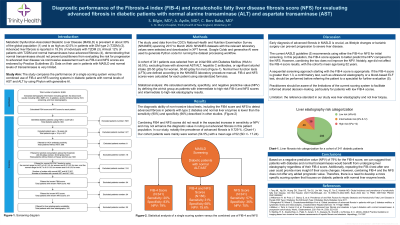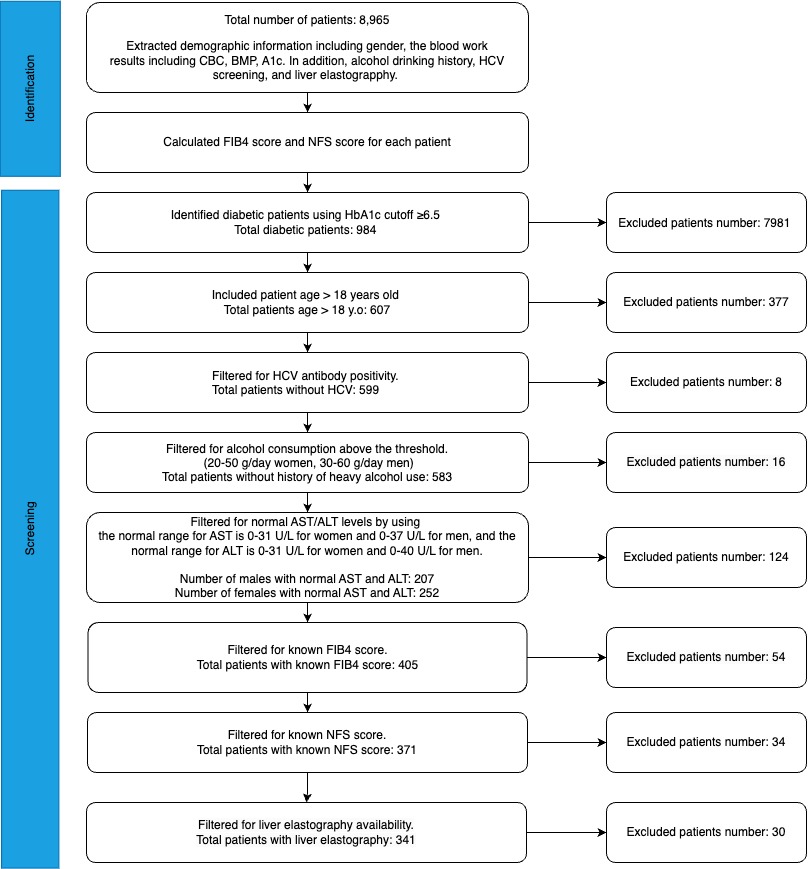Sunday Poster Session
Category: Liver
P1217 - Diagnostic Performance of The Fibrosis-4 Index and Nonalcoholic Fatty Liver Disease Fibrosis Score for Evaluating Advanced Fibrosis in Diabetics With Normal Alanine Transaminase and Aspartate Aminotransferase
Sunday, October 27, 2024
3:30 PM - 7:00 PM ET
Location: Exhibit Hall E

Has Audio

Seyma Bilgin, MD
Saint Mary's Hospital
Berlin, CT
Presenting Author(s)
Seyma Bilgin, MD1, Adem Aydin, MD2, Carolina Borz Baba, MD2
1Saint Mary's Hospital, Berlin, CT; 2St. Mary's Hospital, Waterbury, Waterbury, CT
Introduction: An estimated 20% of Metabolic Dysfunction-Associated Steatohepatitis (MASH) cases with advanced fibrosis progress to cirrhosis within two years. The 2024 guidelines from the American Association for the Study of Liver Diseases (AASLD) recommend using both the Fibrosis-4 index (FIB-4) and the nonalcoholic fatty liver disease fibrosis score (NFS) to detect advanced fibrosis in high-risk patients. This study aimed to compare the performance of a single scoring system versus the combined FIB-4 and NFS scoring systems in the diabetic population with normal aspartate aminotransferase (AST) and alanine transaminase (ALT) levels.
Methods: Our study utilized the Center for Disease Control (CDC) National Health and Nutrition Examination Survey (NHANES) dataset from 2017 to March 2020. We identified 984 patients with Diabetes Mellitus (DM), defined as glycated hemoglobin levels of ≥6.5%. We then filtered these patients to include only those with normal AST/ALT levels. Excluding patients with hepatitis C antibodies and significant alcohol consumption (20-50 g/day for women, 30-60 g/day for men) resulted in a cohort of 370 patients (Figure 1). We categorized the patients into low, intermediate, and high-risk categories based on the FIB-4, NFS scores, and liver stiffness by elastography. The cutoff values for low and high risk were 1.3 vs. 2.67 for the FIB-4 score, -1.455 vs. 0.675 for the NFS score. Regarding liver stiffness measurements, the cutoffs for low and high-risk values were 8 vs.12 kilopascal (kPa). To calculate the sensitivity, specificity, and negative predictive value (NPV) we defined the at-risk group as those who had intermediate to high-risk FIB-4 and NFS scores and intermediate to high risk by elastography.
Results: The sensitivity and specificity for FIB-4 were 19.5% and 82.6% respectively with a NPV of 78.3%. The sensitivity and specificity for NFS were 56.76% and 35.96% respectively with an NPV of 75%. The final analysis combined the FIB-4 score and NFS score and demonstrated a sensitivity of 18.4%, specificity of 74.4%, and NPV of 75.6%.
Discussion: Our study highlights the limitations of using the combination of FIB-4 score and NFS score as primary screening tools for liver fibrosis in DM patients with normal AST/ALT levels. The addition of NFS to the FIB-4 score, as per the recent AASLD recommendations, does not seem to increase the NPV in this population. Further research is needed to develop and validate more effective screening strategies for this high-risk population.

Disclosures:
Seyma Bilgin, MD1, Adem Aydin, MD2, Carolina Borz Baba, MD2. P1217 - Diagnostic Performance of The Fibrosis-4 Index and Nonalcoholic Fatty Liver Disease Fibrosis Score for Evaluating Advanced Fibrosis in Diabetics With Normal Alanine Transaminase and Aspartate Aminotransferase, ACG 2024 Annual Scientific Meeting Abstracts. Philadelphia, PA: American College of Gastroenterology.
1Saint Mary's Hospital, Berlin, CT; 2St. Mary's Hospital, Waterbury, Waterbury, CT
Introduction: An estimated 20% of Metabolic Dysfunction-Associated Steatohepatitis (MASH) cases with advanced fibrosis progress to cirrhosis within two years. The 2024 guidelines from the American Association for the Study of Liver Diseases (AASLD) recommend using both the Fibrosis-4 index (FIB-4) and the nonalcoholic fatty liver disease fibrosis score (NFS) to detect advanced fibrosis in high-risk patients. This study aimed to compare the performance of a single scoring system versus the combined FIB-4 and NFS scoring systems in the diabetic population with normal aspartate aminotransferase (AST) and alanine transaminase (ALT) levels.
Methods: Our study utilized the Center for Disease Control (CDC) National Health and Nutrition Examination Survey (NHANES) dataset from 2017 to March 2020. We identified 984 patients with Diabetes Mellitus (DM), defined as glycated hemoglobin levels of ≥6.5%. We then filtered these patients to include only those with normal AST/ALT levels. Excluding patients with hepatitis C antibodies and significant alcohol consumption (20-50 g/day for women, 30-60 g/day for men) resulted in a cohort of 370 patients (Figure 1). We categorized the patients into low, intermediate, and high-risk categories based on the FIB-4, NFS scores, and liver stiffness by elastography. The cutoff values for low and high risk were 1.3 vs. 2.67 for the FIB-4 score, -1.455 vs. 0.675 for the NFS score. Regarding liver stiffness measurements, the cutoffs for low and high-risk values were 8 vs.12 kilopascal (kPa). To calculate the sensitivity, specificity, and negative predictive value (NPV) we defined the at-risk group as those who had intermediate to high-risk FIB-4 and NFS scores and intermediate to high risk by elastography.
Results: The sensitivity and specificity for FIB-4 were 19.5% and 82.6% respectively with a NPV of 78.3%. The sensitivity and specificity for NFS were 56.76% and 35.96% respectively with an NPV of 75%. The final analysis combined the FIB-4 score and NFS score and demonstrated a sensitivity of 18.4%, specificity of 74.4%, and NPV of 75.6%.
Discussion: Our study highlights the limitations of using the combination of FIB-4 score and NFS score as primary screening tools for liver fibrosis in DM patients with normal AST/ALT levels. The addition of NFS to the FIB-4 score, as per the recent AASLD recommendations, does not seem to increase the NPV in this population. Further research is needed to develop and validate more effective screening strategies for this high-risk population.

Figure: Figure-1: Flow Diagram for Identifying and Screening Diabetic Patients with Normal AST/ALT Levels for Risk Analysis of Steatotic Liver Disease Using CDC NHANES Datasets (2017 - March 2020)
Disclosures:
Seyma Bilgin indicated no relevant financial relationships.
Adem Aydin indicated no relevant financial relationships.
Carolina Borz Baba indicated no relevant financial relationships.
Seyma Bilgin, MD1, Adem Aydin, MD2, Carolina Borz Baba, MD2. P1217 - Diagnostic Performance of The Fibrosis-4 Index and Nonalcoholic Fatty Liver Disease Fibrosis Score for Evaluating Advanced Fibrosis in Diabetics With Normal Alanine Transaminase and Aspartate Aminotransferase, ACG 2024 Annual Scientific Meeting Abstracts. Philadelphia, PA: American College of Gastroenterology.
